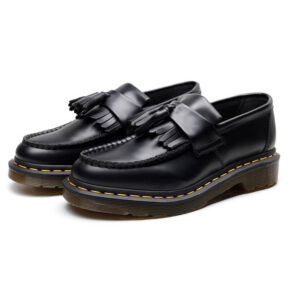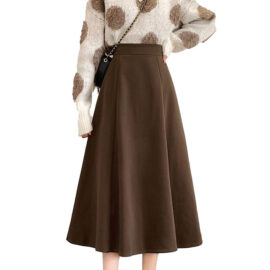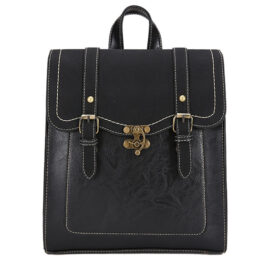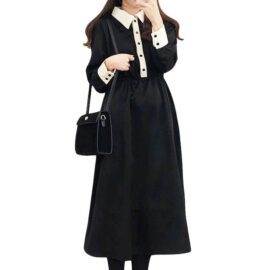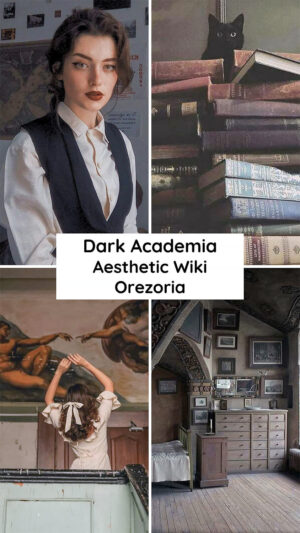
The Dark Academia aesthetic is a fashion and lifestyle trend that celebrates the pursuit of knowledge, classical literature, and the allure of prestigious institutions. It borrows its inspiration from classic literary works, such as those by Oscar Wilde, Jane Eyre, Emily Dickinson, and Toni Morrison, as well as the academic environments of Western universities.
With its roots in the world of literature and academia, the Dark Academia aesthetic is characterized by its emphasis on intellectualism, a love for classic literature, and a passion for learning. It is often associated with a color scheme that embraces dark and neutral tones, creating an atmosphere of intellectual depth and sophistication.
The aesthetic also draws from the clothing style of traditional academic institutions, featuring elements such as tweed blazers, collared shirts, and Mary Jane shoes. This fashion trend has gained significant popularity on social media platforms, as content creators and enthusiasts alike come together to share their love for the Dark Academia vibe.
The Dark Academia aesthetic has also opened up conversations about inclusivity, with efforts to make the community more accessible and welcoming to people of color and marginalized groups. By exploring and appreciating classic literature and the pursuit of knowledge, the Dark Academia aesthetic offers a way for individuals to connect with a rich cultural capital and cultivate a love for learning in their everyday lives.
Related aesthetics: Addamscore, Celestial, Ethereal, Goblincore, Gothic, Light Academia, Retro, Vampire, Vintage, Witchy Academia
Full List of Aesthetics
Origins of the Dark Academia Aesthetic
The Dark Academia aesthetic emerged as a subculture and lifestyle trend, gaining significant popularity during the coronavirus pandemic. It became a source of solace and escapism for many individuals seeking a deeper connection to literature and intellectual pursuits.
The origins of the Dark Academia aesthetic can be traced back to traditionalist tendencies in contemporary fashion. It draws inspiration from classic literature, Western universities, and the pursuit of knowledge. This aesthetic resonated with people who longed for the intellectual depth and sophistication associated with prestigious institutions.
During the pandemic, with many individuals staying at home and seeking meaningful ways to spend their time, the Dark Academia aesthetic offered an immersive experience through its focus on literature, art, and music. By exploring the works of authors such as Jane Eyre and Oscar Wilde, individuals engaged in the pursuit of knowledge and self-improvement.
Blurring the boundaries between a lifestyle and a subculture, the Dark Academia aesthetic finds expression not only in clothing style but also in everyday life. It extends beyond fashion choices and encompasses a passion for learning, socializing in coffee shops, and participating in book clubs. The aesthetic has provided a sense of community for individuals with a shared appreciation for the classics and a desire to embrace a more intellectual and introspective way of living.
Influences on Dark Academia
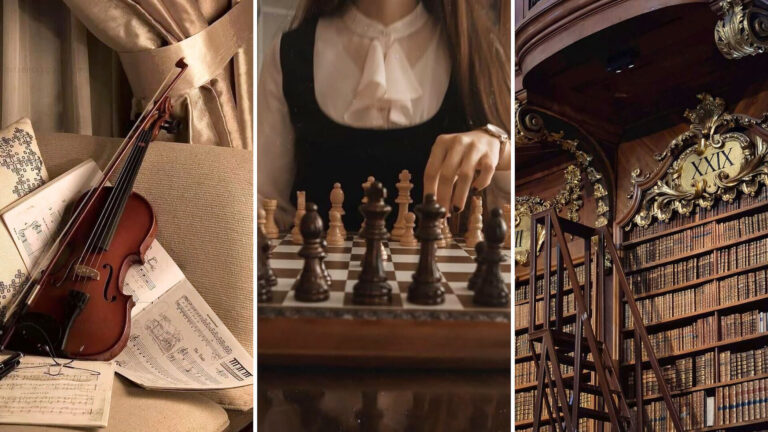
The Dark Academia aesthetic, while popular among certain circles, has received criticism for its influences, which are predominantly white and Eurocentric. This aesthetic often romanticizes a pre-civil rights era and upholds harmful systems of oppression.
By primarily drawing inspiration from classic literature and Western universities, Dark Academia tends to exclude other cultural narratives and perspectives, limiting its appeal and accessibility for people of color. The focus on prestigious institutions and the pursuit of knowledge can reinforce elitism and the privileging of certain types of education.
Moreover, the romanticization of the past can gloss over historical realities and perpetuate a narrow and idealized view of history. This can inadvertently romanticize oppressive systems that marginalized and oppressed groups have fought against.
Critics argue that Dark Academia should strive to be more inclusive and actively work to dismantle systems of oppression. By broadening its influences and embracing a wider range of voices and perspectives, the aesthetic can evolve into a more inclusive and empowering space. It is important to engage critically with the influences of Dark Academia and strive for a more diverse and equitable representation within the aesthetic.
Dark Academia as a Lifestyle
Dark Academia is not just a fashion trend, but a lifestyle that encompasses various activities, hobbies, and a distinct aesthetic sensibility. At its core, Dark Academia revolves around the pursuit of knowledge and intellectual growth. It is a subculture that values expanding knowledge in disciplines such as classical literature, history, foreign languages, mythology, art, and philosophy.
Reading is a central aspect of Dark Academia, with a focus on classic literature and the works of renowned authors like Jane Eyre, Oscar Wilde, Emily Dickinson, and Toni Morrison. This love for literature often extends to forming book clubs and engaging in literary discussions.
The melancholic and gothic elements associated with Dark Academia create a sense of romanticism and mystery. This aesthetic is often reflected in clothing choices, with dark colors, tweed blazers, and Mary Janes being popular choices among enthusiasts. Coffee shops, libraries, and cozy reading nooks become preferred spaces for indulging in these interests.
Dark Academia as a lifestyle encourages introspection, critical thinking, and a deep appreciation for the arts and academia. It represents a yearning for intellectual growth, a desire to explore the complexities of the human condition, and a longing for the ambiance of prestigious institutions and the pursuit of knowledge.
Types of Dark Academia Sub Styles and Related Aesthetics
Academia Aesthetic is not a singular aesthetic but rather a realm of various sub-styles and related aesthetics that share common elements. These sub-styles include various styles, which embodies a similar passion for knowledge but embraces brighter and softer color palettes. Additionally, there are distinct influences from Western universities, boarding schools, and the pursuit of a liberal education. Let’s overview some of the most popular academia styles:
Light Academia
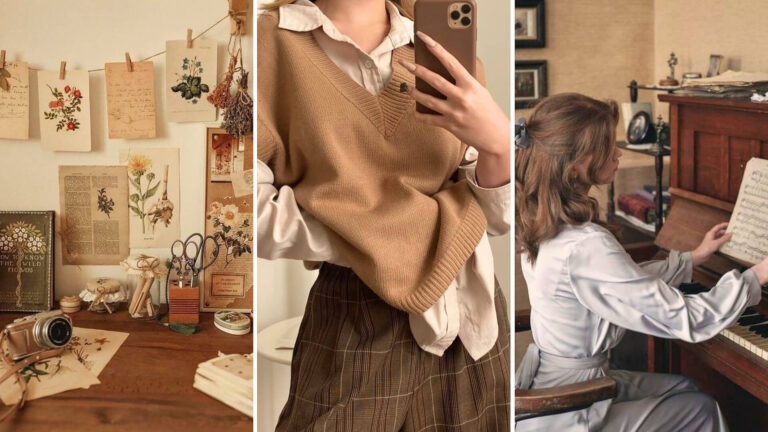
Light Academia is a refreshing and optimistic approach to the popular Dark Academia aesthetic. While still embracing classic and retro elements, it takes a brighter and sunnier outlook on life and socializing.
The key feature of Light Academia fashion is the use of lightweight fabrics that allow for comfort and movement. The color palette is fresh and light, with shades of pastels and soft neutrals dominating the wardrobe. Floral prints and delicate patterns add a touch of whimsy to outfits, reflecting the cheerful disposition of this aesthetic.
Light Academia also emphasizes the importance of socializing and building connections, often seen through gatherings in outdoor settings, like picnics or garden parties. It balances intellectual pursuits with a focus on enjoying everyday life and fostering meaningful relationships.
In contrast to its darker counterpart, Light Academia embraces a more inclusive and diverse community. This aesthetic recognizes that the pursuit of knowledge should be accessible to everyone, regardless of their background. It strives to create a welcoming environment where people from all walks of life can come together to celebrate their passion for the arts, literature, and learning.
Light Academia is an enchanting blend of classic charm and a sunny outlook on life, appealing to those who appreciate the beauty of the world around them and seek to make lasting connections.
Romantic Academia
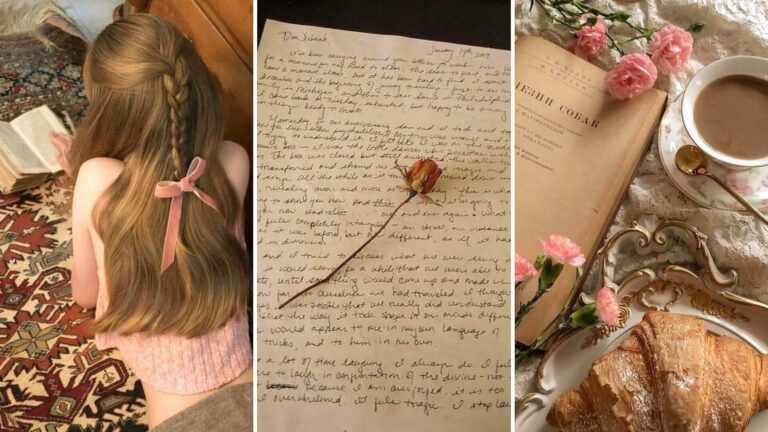
Romantic Academia is a subset of the larger Dark Academia aesthetic that captures the romanticization of the past and the longing for an idealized academic experience. It draws inspiration from the romantic era of literature and art, as well as the gothic elements that permeate classic works.
At its core, Romantic Academia celebrates the beauty and mystique of bygone eras, channeling a sense of nostalgia for a time when intellectual pursuits were highly valued. It embraces the notion of a prestigious institution where learning is revered and scholarly pursuits are cherished.
Gothic literature, with its dark and brooding themes, has a significant impact on Romantic Academia. Works by authors like Edgar Allan Poe and Mary Shelley evoke a sense of mystery and passion that resonates deeply with enthusiasts of this aesthetic. Moreover, gothic architecture, with its grandeur and intricate details, serves as a visual representation of this longing for a romanticized past and the thirst for knowledge.
In the realm of Romantic Academia, individuals immerse themselves in the atmospheric ambiance of dark libraries, walk through winding corridors of historic buildings, and lose themselves in the pages of timeless literary classics. This aesthetic encapsulates a deep appreciation for the arts, the longing for intellectual exploration, and a reverence for the legacy of past scholars.
Art Academia
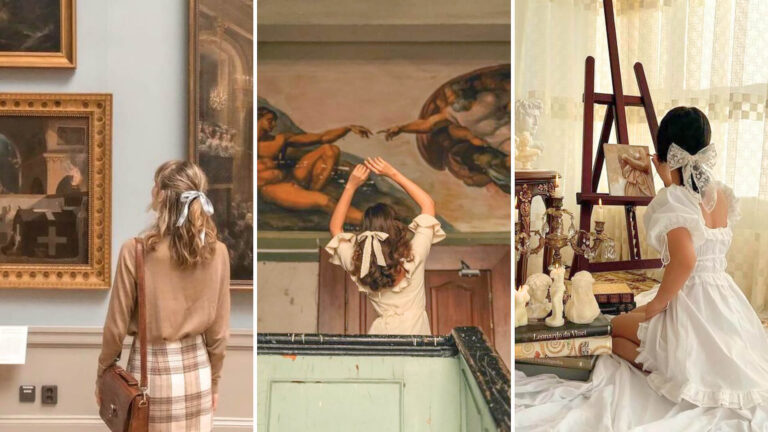
Art Academia is a subset of the broader Dark Academia aesthetic that specifically emphasizes the appreciation of the arts. It delves into the world of visual expression, highlighting the impact of fine arts and artistic creativity on the overall aesthetic.
At its core, Art Academia celebrates the beauty and depth of artistic endeavors, drawing inspiration from various art forms, such as painting, sculpture, and photography. Enthusiasts of this aesthetic immerse themselves in the exploration of artists’ techniques, styles, and artistic philosophies.
Art Academia incorporates the visual language of the arts into its aesthetic, with a focus on embracing creativity and self-expression. The use of color palettes and compositions often mimics the mastery seen in classical paintings and art movements. From muted earth tones to bold and dramatic contrasts, the aesthetic impact of visual expression brings a sense of depth and intrigue to this subcategory of Dark Academia.
Furthermore, Art Academia places value on artistic endeavors beyond literature and academic pursuits. It recognizes the profound impact that artistic creations have on society and personal identity, fostering a passion for creativity and a dedication to showcasing artistic talent.
Witchy Academia
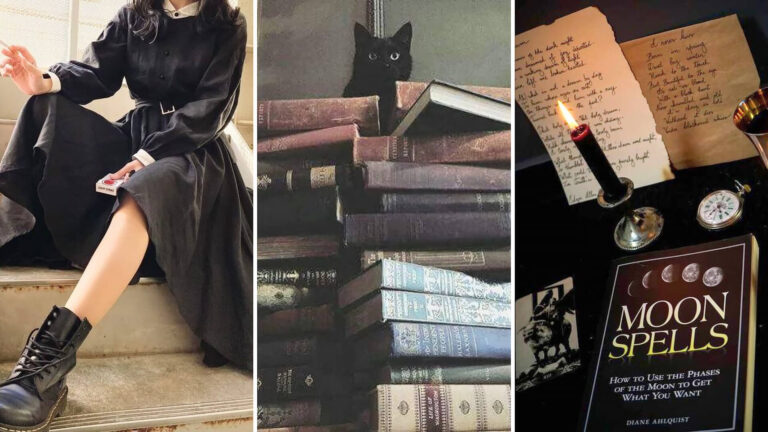
Witchy Academia emerges as a captivating sub-style within the broader realm of Dark Academia, thanks to its enchanting combination of mystical and supernatural elements. This aesthetic not only embraces the intellectual and introspective aspects of Dark Academia but also incorporates the allure and fascination of witchcraft.
In Witchy Academia, academic pursuits and the pursuit of magical knowledge coexist harmoniously, blending the worlds of academia and the occult. This sub-style celebrates the mystical side of academia, where the pursuit of knowledge goes beyond traditional boundaries and delves into the realms of the supernatural.
Drawing inspiration from folklore, mythology, and witchcraft practices, Witchy Academia embraces symbols and motifs associated with the occult. Books on spellcasting, divination, and herbalism find their place alongside classic literature on the shelves, creating a unique fusion of academic and mystical subjects.
The color palette reflects the magical atmosphere, with deep, dark hues interspersed with flashes of vibrant jewel tones. Clothing choices often incorporate flowing fabrics, layered textures, and accessories like crystal jewelry or tarot-inspired prints.
Witchy Academia offers an opportunity to explore the intersection of academia and the mystical, enchanting those who are drawn to both dark academia and witchcraft. It is a celebration of the supernatural, where the pursuit of knowledge extends into the realm of magic and mysticism, creating a uniquely enchanting aesthetic.
Darkest Academia
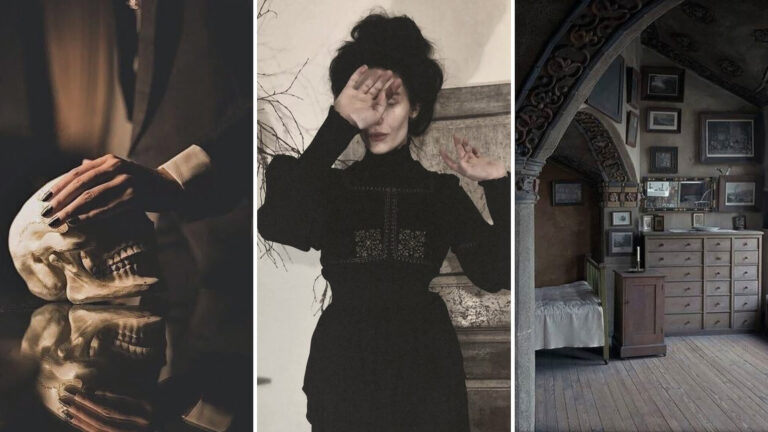
Darkest Academia takes the essence of the Dark Academia aesthetic and dives into the depths of darkness, exploring themes of death, the occult, and more sinister pursuits. While Dark Academia focuses on the intellectual pursuit of knowledge and appreciation for classical literature and art, Darkest Academia takes it to the extreme, embracing the darker aspects of academia.
This sub-style immerses itself in the macabre, drawing influence from Gothic literature, occult symbolism, and the exploration of life and death. It delves into the mysteries of the afterlife, often incorporating elements such as necromancy and summoning rituals. The color palette of Darkest Academia reflects this eerie ambiance, featuring deep blacks, blood reds, and shadowy greys.
Literary works like Edgar Allan Poe’s macabre tales and Mary Shelley’s Frankenstein resonate strongly with the Darkest Academia aesthetic. Artistic expressions like spooky illustrations and haunting photography can also be found within this sub-style. Pop culture references, such as Tim Burton’s films or Neil Gaiman’s works, further align with the Darkest Academia aesthetic.
Darkest Academia embraces the enigmatic, the arcane, and the eerie, creating a sub-style that caters to those who find beauty in the shadows of knowledge and the mysteries of the academic world.
Dark Academia Aesthetic Fashion and Outfits Guide
The Dark Academia aesthetic is not only reflected in literature and art, but also in fashion. It is a style that celebrates the pursuit of knowledge, intellectual curiosity, and classical beauty. Dark Academia fashion is characterized by its timeless and sophisticated appearance, taking inspiration from classic literature, vintage styles, and the allure of collegiate life.
Dark Academia Clothing
Dark Academia clothing is characterized by its distinct color palette, materials, and styles, drawing inspiration from the academic elegance of the 1930s, 1940s, and 1950s. This fashion trend seamlessly combines retro smart casual with a modern twist.
The color palette of Dark Academia clothing tends to be dark and moody, featuring shades such as deep burgundy, forest green, navy blue, and black. These colors evoke a sense of intellectual sophistication and mystery.
In terms of materials, Dark Academia fashion favors fabrics like wool, tweed, corduroy, and velvet, which add texture and depth to the outfits. These materials give a nod to the historical and vintage elements that inspire the aesthetic.
Styles within the Dark Academia wardrobe include oversized jackets, warm jumpers, maxi skirts, coats, and leather boots. These pieces not only evoke a nostalgic charm but also provide comfort and functionality for everyday wear.
One key aspect of Dark Academia fashion is the concept of retromania, where elements of the past are reinterpreted through contemporary aesthetic sensibilities. This allows for a modern twist on classic pieces, making the style accessible and adaptable to different preferences.
You can find more Dark Academia clothing and accessories in our Dark Academia Outfits Collection.
Try our new Aesthetic Outfits AI to Try-on Clothes.
Dark Academia Accessories
Dark Academia Accessories play a significant role in the dark academia aesthetic and subculture, enhancing the scholarly vibe and contributing to the overall aesthetic. These accessories not only add a touch of sophistication but also reflect the pursuit of knowledge and passion for learning that are central themes in dark academia.
Dark Academia Accessories encompass a wide range of items that exude a nostalgic charm and intellectual appeal. Classic literature-inspired accessories like book-shaped clutches, necklaces with literary quotes, or brooches adorned with iconic symbols from beloved novels, such as quills or vintage typewriters, are popular choices among dark academics. These pieces not only showcase a love for literature but also serve as conversation starters and a means of self-expression.
In addition to literary-inspired accessories, dark academics often embrace other elements of the aesthetic, such as academic-themed jewelry like small mortarboard or owl-shaped earrings, antique-inspired pocket watches, or ornate fountain pens. These accessories add a touch of elegance and refinement to any outfit, creating a cohesive and polished look.
Dark Academia Accessories are not just about aesthetics; they also contribute to the subculture’s sense of identity and community. By wearing these accessories, dark academics subtly communicate their affiliation with the aesthetic and signal their shared interests and values. It is through these accessories that the dark academia vibe is effortlessly maintained and celebrated.
Dark Academia Makeup
Dark Academia Makeup embraces a dramatic color palette and focuses on enhancing natural features to achieve a timeless and intellectual look. One of the key elements of this aesthetic is well-defined and slightly thickened eyebrows. They frame the face and draw attention to the eyes, conveying a serious and studious vibe.
Another essential technique is the use of winged eyeliner, which adds a touch of sophistication and mystery to the overall look. This classic technique creates a dramatic and bold eye shape that is synonymous with the dark academia aesthetic.
Muted lip colors, such as deep reds, browns, or soft mauves, play a crucial role in completing the dark academia makeup look. These colors complement the overall color palette, adding depth and a touch of vintage charm to the face.
A porcelain-like complexion is a key element in achieving the dark academia aesthetic. The focus is on creating a flawless and smooth base, using foundation and concealer to achieve an even skin tone. Subtle contouring techniques are then employed to enhance the features, adding dimension and structure to the face.
By combining these techniques and incorporating the dark and dramatic color palette, Dark Academia Makeup effortlessly captures the nostalgic and intellectual essence of the aesthetic.
Dark Academia Hairstyles
Dark academia hairstyles are an integral part of the overall aesthetic, capturing the vintage charm and scholarly vibe that characterizes this trend. Drawing inspiration from the past, these hairstyles add an element of sophistication and intellect to one’s overall look.
Braids are a popular choice within the dark academia aesthetic. Whether it’s a classic French braid, a fishtail braid, or a milkmaid braid, these styles evoke a sense of timeless elegance and intellectual pursuits. Braids can be worn neatly and tightly for a more polished appearance or loosely for a relaxed and effortless vibe.
Updos are another staple of dark academia hairstyles. From low chignons to intricate bun styles, these hairstyles instantly elevate a look, adding a touch of sophistication and refinement. Updos can be accessorized with vintage-inspired hairpins or ribbons for an extra touch of elegance.
Loose waves are often seen as a more laid-back yet sophisticated option within the dark academia aesthetic. Achieved through gentle curls or a tousled texture, loose waves lend a romantic and slightly disheveled appeal, reminiscent of literary figures lost in their studies.
Buns, particularly low or messy buns, also embody the dark academia aesthetic. Created by twisting the hair and securing it at the nape of the neck, buns exude an effortless yet academic vibe, perfect for long hours spent buried in books.
Incorporating these hairstyles into your dark academia look can enhance the overall vintage vibe and scholarly appearance. Whether it’s braids, updos, loose waves, or buns, these hairstyles complement the aesthetic, allowing you to embody the passion for knowledge and pursuit of intellectual endeavors associated with dark academia.
Dark Academia Nails and Nail Art
Dark Academia nails are a perfect way to showcase your love for classic literature and academic pursuits. These nail art styles and designs align with the Dark Academia aesthetic by incorporating elements such as dark colors, symbolism, and vintage-inspired patterns.
One popular choice for Dark Academia nails is using dark colors such as deep burgundy, forest green, and rich navy blue. These colors evoke a sense of mystery and intellectual depth, aligning perfectly with the aesthetic. Symbolism also plays a significant role in Dark Academia nail art, with motifs like moons, stars, feathers, and quills often incorporated into the designs. These symbols represent knowledge, wisdom, and the pursuit of learning.
Vintage-inspired patterns are another hallmark of Dark Academia nails. Think intricate lace designs, delicate floral patterns, and ornate filigree. These vintage patterns give your nails a sense of timeless elegance and sophistication.
Achieving Dark Academia nail art can be done in various ways. You can opt for minimalist designs using neutral colors like beige or gray, which still capture the essence of the aesthetic. Alternatively, you can go for more intricate designs with detailed patterns and symbols.
For the ultimate Dark Academia touch, consider incorporating literature or academic-inspired themes into your nail art. Quotes from your favorite authors, tiny book illustrations, or even mini typewriters can add a unique and personal touch to your nails.
Tips on How to Create Your Dark Academia Outfit
Creating a Dark Academia outfit is all about embracing the intellectual and mysterious atmosphere that this aesthetic embodies. Here are a few tips on how to achieve the perfect look:
- Embrace earthy brown colors: When it comes to Dark Academia, earthy brown tones like deep maroon, olive green, and chocolate brown are the go-to colors. These colors evoke a sense of intellectual depth and capture the vintage charm associated with classic literature.
- Layering and textures: Experiment with layering different textures to add dimension to your outfit. Think tweed blazers, chunky knit sweaters, and pleated skirts. These pieces not only add visual interest but also give a nod to the academic life and prestigious institutions associated with Dark Academia.
- Accessorize with bookish elements: Incorporate bookish elements into your outfit to truly capture the essence of Dark Academia. Consider wearing glasses with a vintage touch, carrying a leather satchel, or accessorizing with a pocket watch. These details add an intellectual and literary vibe to your overall look.
- Atmosphere of books and coffee: Dark Academia is all about the love for knowledge and the cozy atmosphere of libraries and coffee shops. Opt for cozy knitted scarves, berets, or a classic tailored coat to channel that bookish ambiance.
Remember, Dark Academia is a highly individualistic aesthetic, so feel free to add your own personal touches and experiment with different elements. Ultimately, the key is to embrace the intellectualism and vintage charm that this aesthetic represents.
The Pursuit of Knowledge
The Dark Academia aesthetic goes beyond just a fashion trend or a literary preference; it embodies a deep yearning for knowledge and intellectual growth. Rooted in classic literature, this aesthetic embraces the romance of timeless novels and the allure of vintage academia. It is inspired by the pursuit of knowledge that is often associated with prestigious institutions and academic life.
Dark academia enthusiasts are drawn to the intellectual curiosity that drives characters like Jane Eyre, who seek education and personal growth. It celebrates the love for learning and the passionate quest for enlightenment, encouraging individuals to explore various fields of study and cultivate their intellectual capabilities.
Whether through reading, engaging in deep conversations, or immersing oneself in the arts, the pursuit of knowledge remains at the core of the dark academia community, fostering a culture that values education, critical thinking, and a thirst for understanding the world around us.
Prestigious Institutions & Western Universities
The dark academia aesthetic draws its inspiration from the historical prestige and academic life of prestigious institutions and Western universities. These institutions have played a significant role in shaping the dark academia aesthetic due to their rich history and association with intellectual pursuits.
However, it is important to acknowledge the problematic history and exclusionary practices of these institutions. Many prestigious universities were built on land worked by enslaved people, and their early curriculum and admissions policies were often designed to exclude marginalized communities. This historical context brings attention to issues of representation and access to higher education, particularly for BIPOC students.
Despite these issues, certain universities have become emblematic of the dark academia aesthetic. Institutions such as Oxford, Cambridge, Harvard, and Yale are often associated with this aesthetic due to their long-standing traditions, stunning architecture, and esteemed reputations.
It is crucial to approach the dark academia aesthetic with a critical lens, acknowledging the need for diversity and inclusion within these institutions. By embracing a more inclusive approach, the dark academia aesthetic can better reflect the realities and experiences of individuals from all backgrounds within the realm of academia.
The Romanticization of the Past
The concept of romanticization of the past lies at the heart of the Dark Academia aesthetic. It involves idealizing and glamorizing the bygone eras of academic life, particularly those associated with classical literature, prestigious institutions, and the pursuit of knowledge. Dark Academia portrays a fantasy of the academic experience deeply rooted in a time that is becoming increasingly inaccessible.
This aesthetic is often characterized by its reverence for classical literature, love for intellectual pursuits, and admiration for the intellectual elite. It draws inspiration from authors like Oscar Wilde, Jane Eyre, and Emily Dickinson, as well as the ambiance of old libraries, dusty bookshelves, and sprawling university campuses.
However, it is important to critically analyze and acknowledge the implications of romanticizing the past without considering its problematic aspects. Dark Academia tends to focus on the beauty and romance of academia, often overlooking the exclusionary practices, elitism, and systemic biases that plagued historical institutions.
By indulging in this romanticized version of the past, it is crucial to recognize the responsibility of understanding and addressing the problematic history associated with these institutions. This includes acknowledging their contributions to systemic inequalities and the limited access marginalized communities had to such educational institutions.
Critique of Dark Academia
While the Dark Academia aesthetic may be appealing to many, it is not without its criticisms. One of the main concerns is the lack of inclusivity within this subculture. Dark Academia often focuses on a narrow representation of academia, centered around predominantly white individuals and Eurocentric literature. This exclusionary approach can alienate and marginalize people of color and other underrepresented groups who do not see themselves reflected in this aesthetic.
Moreover, Dark Academia has been criticized for its romanticization of a pre-integration era. By idealizing a time when education and intellectual pursuits were often limited to privileged individuals, it overlooks the historical struggles and achievements of marginalized communities. This romanticization perpetuates harmful stereotypes and fails to acknowledge the inequalities and discrimination that existed within these prestigious institutions.
Another criticism is the potential superficiality of the Dark Academia aesthetic. Some argue that it has become more about fashion and aesthetics rather than genuine intellectual pursuits. The focus on specific clothing styles, bookshelves, and coffee shops can overshadow the actual engagement with knowledge and critical thought. This can result in a surface-level engagement with academia, where appearance takes precedence over substance.
Furthermore, Dark Academia can be seen as a fetishization of intellectual life. By reducing academia to an aesthetic and adopting its symbols without engaging with the pursuit of knowledge, it becomes a form of voyeurism rather than a genuine commitment to education.
Impact of Dark Academia Aesthetic on Fashion
The Dark Academia aesthetic has made a significant impact on the fashion industry, gaining popularity as a fashion trend among content creators on platforms like Instagram, TikTok, and Pinterest. With its emphasis on classic literature, intellectual pursuits, and prestigious institutions, the Dark Academia aesthetic has captured the attention of many who seek to express their love for knowledge and culture through their clothing choices.
Fashion has always been a means of expressing one’s personality, lifestyle, and beliefs, and the Dark Academia aesthetic has become a popular form of self-expression. By incorporating elements such as tweed blazers, pleated skirts, loafers, and accessories like scarves and berets, individuals can effortlessly embody the timeless elegance associated with the aesthetic. The color scheme of dark and neutral tones, inspired by the academic environment, further adds to the allure.
This fashion trend has taken social media platforms by storm, with hashtags like #darkacademia and #darkacademiatrend amassing millions of posts. Through curated outfit ideas, book recommendations, and aesthetics, fashion enthusiasts are able to foster a sense of belonging within the Dark Academia community.
Classical Music in the Aesthetic
Classical music plays a vital role in the captivating world of the dark academia aesthetic, contributing to its calming and emotional atmosphere. With its rich and intricate compositions, classical music evokes a sense of introspection and contemplation that beautifully aligns with the somber nature of this aesthetic.
Composers such as Ludwig van Beethoven and Frédéric Chopin are particularly revered within the dark academia community for their ability to convey profound emotions through their music. Beethoven’s “Moonlight Sonata” with its melancholic and introspective melody, perfectly captures the essence of this aesthetic. Chopin’s works, such as “Nocturne in E-flat Major” and “Prelude in D-flat Major,” also possess a haunting beauty that resonates deeply with dark academia enthusiasts.
Other notable classical pieces that align with the dark academia aesthetic include Claude Debussy’s “Clair de Lune,” known for its ethereal and dreamlike quality, and Gustav Mahler’s “Symphony No. 5,” which takes listeners on an emotional journey through its powerful and evocative movements.
By integrating classical music into their daily lives, dark academia enthusiasts immerse themselves in a world of harmonious tranquility and emotional depth. These compositions provide the perfect backdrop for intellectual pursuits, reading, or simply embracing the introspective moments that define this captivating aesthetic.
Dark Academia in Movies and Cinematography
Dark Academia has also made its mark on the world of movies and cinematography, with many films embracing its distinctive aesthetic. The genre’s influence is evident in the use of shadows and muted filters, creating an atmosphere that perfectly encapsulates the dark and mysterious aspects of academia.
The presence of shadows in Dark Academia films serves as a metaphor for the darker side of education and intellectual pursuits. They symbolize secrecy, hidden knowledge, and even the sinister aspects of prestigious institutions. By using shadows, filmmakers can critique academia, highlighting its flaws and exploring themes of power, manipulation, and secrecy.
Several popular films and TV shows embody the Dark Academia aesthetic. “Dead Poets Society,” directed by Peter Weir, delves deep into the world of an elite boarding school where students grapple with conformity, rebellion, and the pursuit of artistic expression. Another notable mention is “The Secret History,” based on Donna Tartt’s novel, as it delves into the dark and twisted world of a group of classics students.
Other Dark Academia-inspired films and TV shows include “Kill Your Darlings,” “The Talented Mr. Ripley,” and “Good Will Hunting.” These stories explore the complexities of intellectual pursuits and the consequences they can have on individuals.
The Dark Academia Style in Interior Design
The Dark Academia aesthetic is not limited to fashion and literature; it can also be incorporated into interior design to create a captivating and intellectual atmosphere within your living space. Drawing inspiration from classic literature and the pursuit of knowledge, Dark Academia interior design revolves around several key elements and features.
One of the main characteristics of Dark Academia interior design is the use of dark colors. Deep, rich colors such as navy blue, emerald green, and burgundy create a moody and atmospheric ambiance. These dark hues are often paired with warm neutrals like tan or cream to add depth and contrast.
Vintage furniture is another essential component of Dark Academia interior design. Opt for antique pieces with intricate detailing and ornate craftsmanship. Think dark wooden desks, velvet armchairs, and leather-bound sofas. These vintage pieces infuse a sense of history and nostalgia into your space, creating a vintage-inspired aesthetic.
Incorporating bookshelves is a must for any Dark Academia-inspired interior. Fill them with a diverse collection of classic literature and various academic subjects. The bookshelves not only serve as storage but also add to the overall intellectual appeal of the space.
To enhance the cozy and intellectual atmosphere, add candles throughout the room. The gentle flickering of candlelight provides a warm and intimate glow. Opt for candles with scents reminiscent of old libraries, such as leather, parchment, or vanilla.
Lastly, Dark Academia interior design welcomes eclectic artwork as a means of self-expression. Display vintage maps, old scientific illustrations, or portraits of famous authors. These pieces of art not only contribute to the aesthetic but also evoke a sense of curiosity and exploration.
By incorporating these key elements and features, you can create an interior design that embodies the Dark Academia aesthetic, inspiring intellectual pursuits and a cozy yet mysterious atmosphere within your space.
Dark Academia in Architectural Design
Dark Academia heavily influences architectural design, imbuing spaces with a sense of intellectualism, grandeur, and romanticism. Key characteristics associated with this aesthetic include gothic and classical styles, ornate features, and grandiose structures.
Incorporating gothic elements, such as pointed arches, ribbed vaults, and stained glass windows, can evoke a sense of mystery and drama in architectural designs. These elements hark back to the medieval era, connecting the space to a rich history and a sense of the sacred.
Classical architectural styles, such as Greek or Roman, offer a sense of timelessness and elegance to Dark Academia spaces. Columns, pediments, and symmetrical forms reflect a pursuit of knowledge and an appreciation for the enduring beauty of ancient civilizations.
Ornate features, such as intricate plasterwork, carved moldings, and decorative motifs, add richness and depth to architectural designs. These details contribute to the intellectual atmosphere and create visually captivating spaces.
Several buildings exemplify the dark academia aesthetic. The University of Oxford’s Bodleian Library boasts gothic architecture, with its imposing stone façade and soaring spires. The Library of Congress in Washington, D.C., showcases classical elements in its neoclassical design, with its dome, Corinthian columns, and extensive decorative details.
Future of the Dark Academia Aesthetic Beyond 2024
The Dark Academia aesthetic has gained tremendous popularity and influence in recent years, permeating various aspects of fashion, art, literature, and pop culture. As we look ahead to the future, it is evident that the Dark Academia aesthetic is poised to continue evolving and captivating audiences beyond 2024.
One of the notable aspects of the Dark Academia aesthetic is its ability to adapt and incorporate new elements and themes while maintaining its core essence. While it is rooted in classic literature, we can expect to see the aesthetic expand its influences to a broader range of literary works, embracing diverse voices and narratives. This evolution will not only fuel creativity but also bring in new perspectives, enriching the Dark Academia community’s understanding of knowledge and academia.
Fashion, a significant component of the Dark Academia aesthetic, will continue to evolve as well. We may witness the emergence of new fashion trends and adaptations within the aesthetic, blending traditional elements with contemporary styles. This fusion will allow for more inclusivity, inviting individuals from all backgrounds to explore and express their passion for classic academia while maintaining their own unique voices.
Social media platforms play a vital role in sustaining and expanding the Dark Academia community. These platforms provide a space for content creators, book lovers, and enthusiasts to connect, share their interpretations of the aesthetic, and discover new works. As the community continues to grow, we can anticipate a deeper exploration of the aesthetic sensibility across various forms of media, including podcasts, YouTube channels, and dedicated blogging platforms.
In summary, the future of the Dark Academia aesthetic looks promising and exciting. With its ability to adapt, incorporate new elements, and its thriving presence on social media platforms, the aesthetic will continue to inspire, captivate, and evolve well beyond 2024, leaving an indelible mark on fashion, art, literature, and pop culture.
